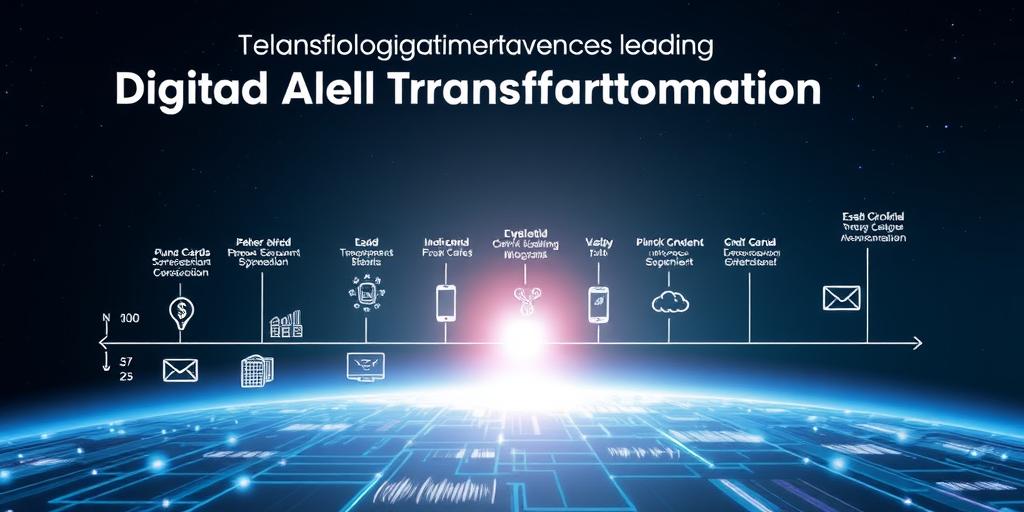Digital transformation has become an indispensable force in today’s business landscape, fundamentally changing the way companies operate, interact with customers, and innovate. But this transformative journey didn’t happen overnight. It’s a story of evolution, marked by key milestones and technological advancements that have shaped the digital world we know today.
Early Days: The Dawn of Digital Transformation (1950s-1980s)
The seeds of digital transformation were sown in the mid-20th century with the advent of computers and data processing. These early machines, though primitive by today’s standards, laid the foundation for the digital revolution to come.
The Rise of Computers and Data Processing
The 1950s saw the development of the first commercial computers, like the IBM 650, which were primarily used for scientific calculations and data processing. This marked the beginning of businesses adopting technology for automation and efficiency.
The Birth of the Internet and Early Web Technologies
The 1960s saw the birth of the internet, initially developed by the US Department of Defense for communication purposes. This paved the way for the development of early web technologies, such as the World Wide Web (WWW) in the 1980s, which allowed for the sharing of information and resources online.
The Digital Revolution: From Desktop to Mobile (1990s-2000s)
The 1990s witnessed the rise of the personal computer and the internet’s explosive growth, transforming businesses and industries. This era also saw the emergence of mobile technology, laying the groundwork for the mobile-first world we live in today.
The Dot-Com Boom and the Rise of E-commerce
The dot-com boom of the late 1990s and early 2000s saw the emergence of e-commerce, where businesses began selling products and services online. Companies like Amazon and eBay revolutionized how consumers shopped, opening up new markets and business models.
The Mobile Revolution and the Rise of Smartphones
The introduction of the first smartphones in the early 2000s, like the Nokia Communicator, ushered in the mobile revolution. These devices put the power of the internet in people’s hands, leading to a shift towards mobile-first experiences and apps.
The Age of Cloud Computing and Big Data (2010s-Present)
The 2010s saw the rise of cloud computing, big data, and artificial intelligence, accelerating digital transformation and shaping how businesses operate today.
The Cloud Computing Revolution
Cloud computing platforms like Amazon Web Services (AWS) and Microsoft Azure made computing resources readily available and accessible to businesses of all sizes, reducing the need for costly infrastructure investments and enabling greater scalability.
The Rise of Big Data and Analytics
The explosion of data generated by digital interactions led to the rise of big data and analytics. Companies began harnessing this data to gain insights into customer behavior, optimize operations, and make better decisions.
The Internet of Things (IoT) and Artificial Intelligence (AI)
The Internet of Things (IoT), connecting everyday devices to the internet, and artificial intelligence (AI) are transforming industries like manufacturing, healthcare, and transportation. AI-powered algorithms and machine learning are automating tasks, improving efficiency, and creating personalized experiences.
The Future of Digital Transformation: Emerging Trends
Digital transformation continues to evolve at a rapid pace, with emerging trends like the metaverse, sustainable practices, and human-centered design shaping the future.
The Metaverse and Web 3.0
The metaverse, a persistent, immersive digital environment, promises to revolutionize how we interact with the world around us. Web 3.0, built on blockchain technology, aims to decentralize the internet and empower users with more control over their data.
Sustainable Digital Transformation
As businesses become more aware of their environmental impact, sustainable digital transformation is gaining momentum. Companies are focusing on using technology to reduce their carbon footprint, promote resource efficiency, and create a more sustainable future.
The Role of Human-Centered Design
In the future, digital transformation will increasingly focus on human-centered design, creating technology that is user-friendly, accessible, and meets the needs of diverse users. This approach ensures that technology enhances our lives and makes a positive impact on society.
Embracing the Future of Digital Transformation
Digital transformation is not a destination but a continuous journey of innovation and adaptation. By embracing emerging technologies, prioritizing sustainability, and focusing on human-centered design, businesses can thrive in the digital age.
The key takeaway is that digital transformation is an ongoing process, and companies must constantly adapt to stay ahead of the curve. By embracing emerging trends and prioritizing user needs, businesses can harness the power of digital transformation to achieve their goals and thrive in the future.




